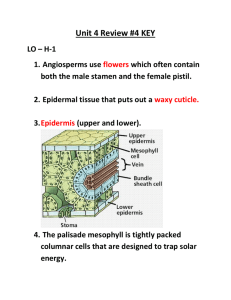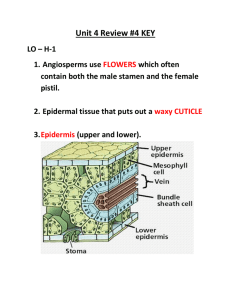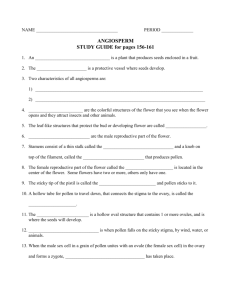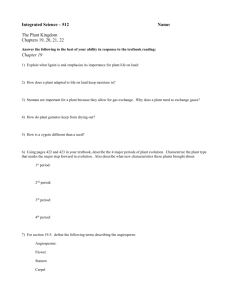ANGIOSPERMS - Doç. Dr. İsmail Eker Kişisel Web Sitesi
advertisement
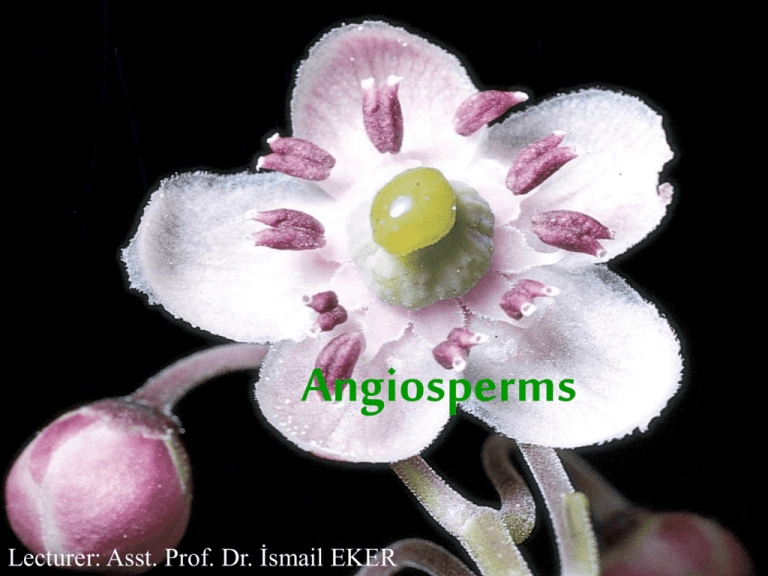
Angiosperms Lecturer: Asst. Prof. Dr. İsmail EKER ANGIOSPERMS (Anthophyta-Flowering plants) The two Seeded Tracheophyte groups are divided by whether or not they have enclosed seeds -protected inside a fruit or if seeds are exposed to the environment. Tracheophytes Seedless Ferns use spores Seeded Gymnosperms Angiosperms “naked” or exposed seeds Flowers produce fruit / enclosed seeds Angiosperms vs Gymnosperm Angiosperm Gymnosperms Seeds surrounded by ovary Seeds naked Fruit present Fruit absent Flower developed Male and female cones developed. Peranth absent or reduced. Scales of female cone equal to angiosperm carpel ; scales of male cone equal to angiosperm stamen With two fertilization - 1 sperm fertilize the With one fertilization (except Gnetophyta) egg (embryo) while the other sperm fertilize two central nuclei (endospermae) Perianth segments arranged verticillate Scales spirally arranged Pollination with wind, insects, birds, bee etc. Generally with wind Herbaceous or woody Generally woody Without resine channels Generally with resine channels Vessels present Vessels absent (except Gnetophyta) Sieve elements present Sieve elements absent Leaves expanded and pendulous (falling) Leaves neddle-like or scale-like and persistent (except Gnetophyta) General characteristics of Angiosperms • With about 250,000 known species, the angiosperms are by far the most diverse and widespread group of land plants. • More than 90% of existing plant species • Contains more than 450 families &13.000 genera; classified mainly by flower structure • As primary producers, flowering plants are at the base of the food web of nearly every terrestrial ecosystem. Taxonomy of Angiosperm • Angiosperms are further divided into 4 major categories: – Basal Angiosperms (older angiosperms like Water lilies) – Magnoliids (Share some traits with basal angiosperms but are more closely related to monocots and eudicots, like the Magnolia) – Monocotyledons – Dicotyledons and/or Eudicotyledons Basal Angiosperms Magnoloids Monocots Dicots Usually spiral arrangement Usually spiral arrangement Usually whorled Usually whorled Often numerous floral parts Few to numerous floral parts Usually in multiples of 3 Usually in multiples of 4-5 Carpels sealed by Carpels sealed by secration cells Carpels sealed by cells Carpels sealed by cells Carpels tubelike Folded carpels Folded carpels Folded carpels Anthers & filaments poorly differentieted Anthers & filaments Anthers & poorly filaments differentieted frequently well differentieted Anthers & filaments well differentieted seed 2-cotyledons 2-cotyledons 1-cotyledons 2-cotyledons Leaf vein Usually netlike Usually netlike Usually parallel Usually netlike Vascular bundle in stem Usually a ring Usually a ring scattered Usually a ring Root system Usually taproot Usually taproot Usually fibrous Usually taproot Flower BASAL ANGIOSPERMS Amborella trichopoda Star anise (Illicium floridanum) Water lily (Nymphaea “Rene Gerard”) MAGNOLIIDS Southern magnolia (Magnolia grandiflora) Eudicots Monocots Magnoliids Star anise and relatives Water lilies Amborella HYPOTHETICAL TREE OF FLOWERING PLANTS Monocot and dicot traits The dicotyledons The monocotyledons Palms and Bananas are Monocots Rice, wheat, corn – all monocots The Angiosperm Life Cycle • In the angiosperm life cycle – Double fertilization occurs when a pollen tube discharges two sperm into the female gametophyte within an ovule – One sperm fertilizes the egg, while the other combines with two nuclei in the center cell of the female gametophyte and initiates development of food-storing endosperm • The endosperm – Nourishes the developing embryo • The reduced gametophytes of seed plants are protected in ovules and pollen grains • In addition to seeds, the following are common to all seed plants – Reduced gametophytes – Heterospory – Ovules – Pollen The life cycle of an angiosperm Key Anthers contain microsporangia. Each microsporangium contains microsporocytes (microspore mother cells) that divide by meiosis, producing microspores. 1 Haploid (n) Diploid (2n) Microsporangium Anther Microsporocytes (2n) Mature flower on sporophyte plant (2n) 2 Microspores form pollen grains (containing male gametophytes). The generative cell will divide to form two sperm. The tube cell will produce the pollen tube. MEIOSIS Microspore (n) Ovule with megasporangium (2n) 7 When a seed germinates, the embryo develops into a mature sporophyte. Generative cell Tube cell Male gametophyte (in pollen grain) Ovary Stigma 3 In the megasporangium of each ovule, the megasporocyte divides by meiosis and produces four megaspores. The surviving megaspore in each ovule forms a female gametophyte (embryo sac). Embryo (2n) Endosperm (food Supply) (3n) 6 The zygote develops into an embryo that is packaged along with food into a seed. (The fruit tissues surrounding the seed are not shown). Pollen grains MEIOSIS Germinating Seed Seed Megasporangium (n) Pollen tube Sperm Surviving megaspore (n) Seed coat (2n) Pollen tube Style Female gametophyte (embryo sac) Antipodal cells Polar nuclei Synergids Egg (n) Pollen tube Zygote (2n) Nucleus of developing endosperm (3n) Egg Nucleus (n) Sperm (n) 4 After pollination, eventually two sperm nuclei are discharged in each ovule. FERTILIZATION 5 Double fertilization occurs. One sperm fertilizes the egg, forming a zygote. The other sperm combines with the two polar nuclei to form the nucleus of the endosperm, which is triploid in this example. Discharged sperm nuclei (n) Parasitic Plants • Derive all or some nutrients from host plant • Parasitic plants have a modified root, the haustorium, that penetrates the host plant and connects to the xylem, phloem, or both, in stems or roots of the host plant. • Examples: Mistletoe, Dodder, Rafflesia Viscum albumMistletoe- Ökseotu Cuscuta japonicaJapanese DodderCinsaçı Rafflesia • World’s the biggest flower • IndonesiaSumatra & Borneo •Up to 1 m diam •10 kg •Lives only one week Carnivorous Plants • Grow in nutrient poor soil such as bogs. • High acidity in bogs prevents growth of muchneeded nitrogen cycle bacteria • Most plants cannot grow in such soil • Carnivorous plants evolved a mechanism to trap and digest insects • This adaptation helped them overcome the nitrate dilemma • Examples: Pitcher plants, sundews, Venus flytrap Dionea (Venus flytrapSinekkapan, böcekkapan) Utricularia (Bladderwort-sumiğferi) Venus Flytrap Drosera (Sundews-Güneşgülü) Nephenthes (Pitcher plant -sürahi , maşrapa bitkisi ) Epiphytes • Plants that attach to other plants • Epiphytes usually derive only physical support and not nutrition from their host, though they may sometimes damage the host. Hence, they are NOT parasitic • They do this to get more light and rain water in a rainforest canopy Bromeliad Orchid Plant Morphology Plant types • Herbs • Shrub • Tree • Vine or liane Flowers Fruits Leaves Stem Roots Plant parts • Vegetative parts (root, stem, bud, leaf) • Generative parts (flower, fruit, seed) Flowering Plant Morphology Reproductive shoot (flower) Apical bud Node Internode Apical bud Vegetative shoot Leaf Shoot system Blade Petiole Axillary bud Stem Taproot Lateral branch roots Root system Plant Morphology - Roots •Roots are multicellular organs with important functions: Anchoring the plant Absorbing minerals and water Storing organic nutrients • Millions of tiny roots hairs in these tip areas help absorption by increasing surface area Roots - Comparisons Taproot • 1 main root • Smaller secondary roots • Strong anchorage • Absorbs deep water Fibrous • No main root • Fast absorption of surface water • Holds soil – prevention of erosion Taproots Typical of dicots, primary root forms and small branch roots grow from it Fibrous roots In monocots mostly, primary root dies, replaced by new roots from stem •A taproot system consists of one main vertical root that gives rise to some large lateral roots, or branch roots. •Adventitious roots arise from stems or leaves. •Seedless vascular plants and monocots have a fibrous root system characterized by many thin lateral roots with no main root. •In most plants, absorption of water and minerals occurs near the root hairs, where vast numbers of tiny root hairs increase the surface area. Plant Morphology - Stems • Herbaceous Plant Plant Morphology- Leaves Leaves are the major photosynthetic parts of most plants. They are borne at the nodes of a stem, usually below a bud. They are usually flat, and have one surface facing towards the stem axis (the adaxial, or upper, surface) and another surface facing away from the stem axis (the abaxial, or lower, surface). Type of leaves – Simple = blade not divided into smaller leaflets – Compound = blade divided into smaller parts that look like small leaves (but lack axillary buds) Leaf Structure - A leaf with a single blade is termed simple; a leaf with two or more blades, or leaflets, is said to be compound. The distinction between simple and compound leaves can be made by locating the axillary bud: an axillary bud is subtended by an entire leaf and never by individual leaflets. Plant Morphology - FLOWER The Flower — What is it? • a flower is a specialized shoot that: 1. has a modified stem with compressed internodes 2. possesses modified leaves with various functions 3. often clustered in an inflorescence (larger branch) The Flower 5. Perianth: collective term for sepals and petals (Tepals if both similar) 4. Petal: the second whorl of leaves, typically brightly colored, attracting pollinators; collectively called the corolla 1. Peduncle: floral stalk, the stem supporting the flower; sometimes referred to as the pedicel 3. Sepal: the outer whorl of leaves, green and protection; collectively called the calyx 2. Receptacle: modified floral stem or axis from which arise the floral appendages or modified leaves The Flower 8. Stamen: the male structure of flower comprising filament and anther • collectively, stamens are the androecium (= ‘house of males’) • can be leaf-like in primitive angiosperms 6. Filament: slender stalk of the stamen supporting the anther; permits exsertion of pollen out of flower 7. Anther: fertile portion of stamen that dehisces to release pollen grains; composed of anther sacs The Flower 13. Pistil: flask-shaped, female structure comprising three main parts • often referred to as carpel(s) • all pistils (1 or more) are referred to as the gynoecium (= ‘house of females’) 9. Ovary: basal portion of pistil that contains ovules; at maturity becomes fruit with seeds 10. Ovules: fertile portions of pistil that contain a female gametophyte (embryo sac); develop into seeds after fertilization 12. Stigma: receptive portion at top of style that receives and recognizes pollen 11. Style: slender stalk of pistil above ovary that the pollen tubes must pass through to reach eggs in ovules Plant Morphology - Fruit = “mature ovary” purpose: protects seeds, dispersal aid Relationship between a pea flower and a fruit (pea pod) Fruit or vegetable? • botanical: – Ripened ovary • Legal – Something that tastes sweet and is eaten as dessert Pericarp • The pericarp is what develops from the ovary wall. It has three layers that widely in structure depending on the fruit: • Exocarp – The outer layer. • Mesocarp – The middle layer. • Endocarp – The inner layer. Seeds Seeds develop from ovules and contain embryonic plant plus nutritive tissue & tough outer coat Embryo. Young sporophyte consisting of epicotyl, hypocotyl, radicle, and one or more cotyledons. Endosperm. Food reserve tissue in seed derived from fertilized polar nuclei; or food reserve derived from megametophyte in gymnosperms. Hilum. Funicular scar on seed coat. Micropyle. Hole through seed coat. Seed Coat. Outer protective covering of seed. Coleoptile. Protective sheath around epicotyl in grasses. Coleorhiza. Protective sheath around radicle in grasses. Cotyledon. Embryonic leaf or leaves in seed. Used for food until the 1st true leaves emerge and the new plant can start to photosynthesis Epicotyl. Apical end of embryo axis that gives rise to shoot system. Hypocotyl. Embryonic stem in seed, located below cotyledons. Plumule. Embryonic leaves in seed derived from epicotyl. Radicle. Basal end of embryo axis that gives rise to root system.
